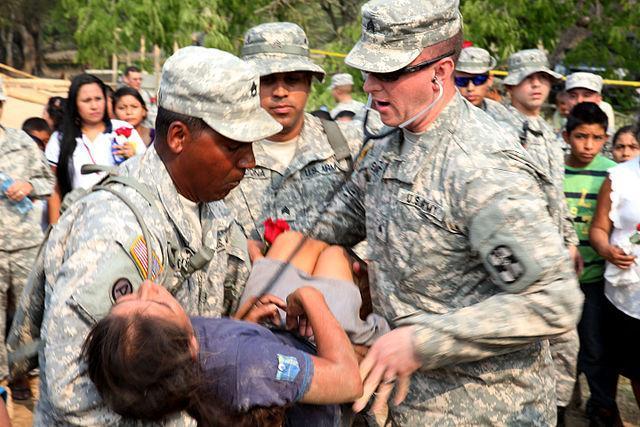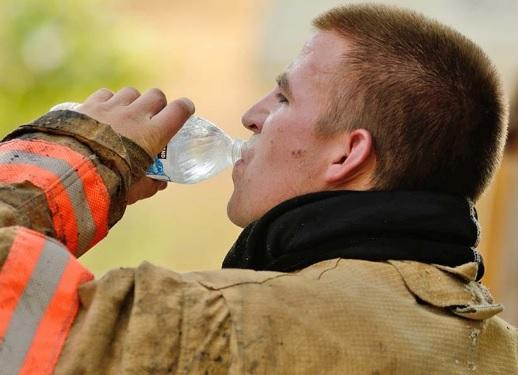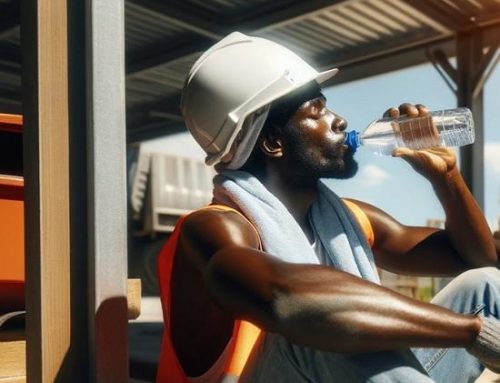Heat Stroke
Heat stroke – it’s the most serious heat-related illness you can face, and it’s important to know what to look for.
Heat stroke happens when your body can’t control its temperature anymore. Your body temperature skyrockets, you stop sweating, and you can’t cool down. And it can happen fast – in just 10 to 15 minutes, your body temperature can reach 106°F or higher. If you don’t get emergency treatment, heat stroke can lead to permanent disability or even death.
According to the Centers for Disease Control, every year, we lose an average of 658 people to the dangers of extreme heat, but the good news is every single one of these deaths and illnesses can be prevented. So, let’s do our part to stay safe and healthy in the summer heat.
The Symptoms of Heat Stroke
So, what should you look out for? Here are some symptoms of heat stroke:
- Confusion, altered mental status, slurred speech
- Loss of consciousness, even slipping into a coma
- Hot, dry skin, or sweating profusely
- Seizures
- A very high body temperature
And let me tell you, if you don’t get treatment fast, heat stroke can be fatal. So, stay cool and stay aware of the symptoms. That way, you can get the help you need if you or someone you know is facing heat stroke.
First Aid Treatment for Heat Stroke
Let’s talk about what you should do if you come across someone who’s suffering from heat stroke. This is a serious situation, and it’s important to act fast.
First things first, call 911 for emergency medical help. Stay with the person until the medical services arrive. Then, move the person to a shady, cool area, and get rid of any outer clothing that might be trapping heat.
Next, you want to cool the person down as quickly as possible. There are a few ways to do that:
- If you’ve got access to a cold water or ice bath, that’s the best option
- Wet the skin with cool water
- Put cold, wet cloths on the skin
- Soak the clothing in cool water
And while you’re doing all that, make sure you’re circulating the air around the person to help speed up the cooling process. And don’t forget to put cold, wet cloths or ice on the head, neck, armpits, and groin, or soak the clothing in cool water.
The most important thing is to act fast and get help. Heat stroke is a serious situation, and every moment counts.

U.S. Army medics assist a Guatemalan woman who passed out from heat stroke during Operation Beyond the Horizon 2014, Zacapa, Guatemala, April 25, 2014. Beyond the Horizon is an annual exercise that embraces the partnership between the U.S. and Guatemala, to provide focused humanitarian assistance through various medical, dental and civic action programs.
Heat Exhaustion
Listen up folks, let’s talk about heat exhaustion. This is a situation that happens when your body loses too much water and salt, usually through excessive sweating. And there are certain people who are more likely to be affected, like the elderly, those with high blood pressure, and anyone working in a hot environment. Heat exhaustion can be serious, especially if you’re already dehydrated or have other health conditions. So, stay alert, stay hydrated, and if you’re feeling any symptoms, take action fast.
The Symptoms of Heat Exhaustion
So, what should you look out for? Here are the symptoms of heat exhaustion:
- Headache
- Nausea
- Dizziness
- Weakness
- Irritability
- Thirst
- Heavy sweating
- Elevated body temperature
- Decreased urine output
If you’re experiencing any of these symptoms, it’s important to take action right away. Drink plenty of fluids, find a cool place to rest, and get out of the heat if you can. And if your symptoms persist or get worse, it’s best to seek medical attention.
First Aid for Heat Exhaustion
How to treat a worker with heat exhaustion:
- Take the worker to a clinic or emergency room for medical evaluation and treatment
- Call 911 if medical care is unavailable and have someone stay with the worker until help arrives
- Remove the worker from the hot area and give them liquids to drink
- Remove unnecessary clothing, including shoes and socks
- Cool the worker with cold compresses or have the worker wash their head, face, and neck with cold water
- Encourage frequent sips of cool water.

A firefighter takes a break during a training exercise. Firefighters and other First Responders are often at high risk of heat stroke and heat exhaustion, especially during the summer months.
Rhabdomyolysis
Now, let’s talk about a condition called rhabdomyolysis or “rhabdo” for short. This is a medical situation that can happen when the body is exposed to heat stress and prolonged physical exertion. Basically, rhabdo causes the rapid breakdown, rupture, and death of muscle, which can release all sorts of nasty stuff into the bloodstream, like electrolytes and large proteins.
Now, if this happens, you could be in for a world of trouble. The released stuff can cause irregular heart rhythms, seizures, and damage to your kidneys. That’s why it’s important to know the symptoms of rhabdo.
The Symptoms of Rhabdomyolysis
So, here’s what you need to look out for:
- Muscle cramps or pain
- Abnormally dark (tea or cola-colored) urine
- Weakness
- Exercise intolerance
- And in some cases, there may be no symptoms at all.
If you’re experiencing any of these symptoms, or if you’re worried about rhabdo, don’t hesitate to seek medical attention. The sooner you get treated, the better off you’ll be.
First Aid for Rhabdomyolysis
If you’re experiencing symptoms of rhabdomyolysis, here’s what you need to do:
- Stop whatever you’re doing right away and take a break
- Drink up! Make sure you’re getting plenty of fluids, water is best
- Head to the nearest medical facility as soon as you can, don’t wait around
- When you get there, make sure they check you for rhabdo. Ask them to take a blood sample and check it for creatine kinase.
This is a serious condition, so it’s important to get treated right away. Don’t ignore the symptoms or try to tough it out, the sooner you get checked out, the better. Stay safe out there.
Heat Syncope
have you ever felt lightheaded or dizzy after standing up too fast, or standing for a long time in the heat? That’s what we call heat syncope. It’s a common issue, especially when you’re dehydrated or haven’t adjusted to the heat yet. So, if you’re feeling a little unsteady on your feet, take a break, sit down, and drink some water. And if it happens regularly, make sure you’re staying hydrated and giving your body enough time to acclimate to the heat.
The Symptoms of Heat Syncope
If you’re feeling dizzy or lightheaded, especially after standing for too long or getting up quickly, you might be experiencing heat syncope. Some of the key symptoms to look out for include:
- Fainting, but only for a short period of time
- Feeling dizzy or unsteady
- Lightheadedness when you’ve been standing for a long time or suddenly rise from a sitting or lying position
First Aid for Heat Syncope
It’s important to take a step back and give your body a break. Here’s what to do if you’re experiencing heat syncope:
- Find a cool, shaded spot to sit or lie down
- Take it slow and drink some water, clear juice, or a sports drink to help rehydrate
It’s important to give your body time to recover, especially if you’re feeling the effects of heat exhaustion. And if it happens regularly, make sure you’re staying hydrated and giving your body enough time to adjust to the heat. And if your symptoms persist, make sure to seek medical attention.
Heat Cramps
If you’re working hard in the heat, you’ve gotta be careful not to sweat too much. When you sweat a lot, you can lose salt and moisture from your body, which can lead to some pretty painful cramps. These are what we call heat cramps.
Now, here’s the thing, if you’re getting heat cramps, it could also be a sign of something more serious, like heat exhaustion. So, it’s important to take a break, hydrate, and make sure you’re not pushing yourself too hard in the heat. And if your symptoms persist, don’t hesitate to seek medical attention.
Symptoms of Heat Cramps
If you’re feeling muscle cramps, pain, or spasms in your tummy, arms, or legs, it might be a sign of heat cramps. This is a common issue for folks who work hard and sweat a lot during the day. When you sweat, you lose salt and moisture from your body, and when your salt levels get low, it can lead to cramps in your muscles. Just keep in mind, heat cramps can also be a symptom of heat exhaustion.
First Aid for Heat Cramps
Here’s what you need to do if you have heat cramps:
- Drink up some water, and chow down on a snack or drink that’ll help replace the carbohydrates and electrolytes you lost. I’m talkin’ about sports drinks, not just water.
- Do not take salt tablets, they’re not the solution.
- Get medical help if the following applies:
- you’ve got heart problems, or
- you are on a low-sodium diet, or
- the cramps don’t go away within an hour
Heat Rash
Heat rash is a common issue when the weather gets hot and humid. Your skin starts to sweat and all that moisture can cause some pretty uncomfortable irritation. It’s just your body’s way of trying to cool down, but it can be a real nuisance.
Symptoms of Heat Rash
If you’re working in hot, humid weather and start noticing clusters of red pimples or small blisters, it could be a case of heat rash. This skin irritation is caused by all that sweating you’re doing, and it’s most likely to pop up in areas like your neck, upper chest, groin, under the breasts, and in the creases of your elbows. Keep an eye out for these symptoms, and take steps to cool down and avoid excessive sweating, to help prevent heat rash from developing.
First Aid for Heat Rash
If you’re dealing with heat rash, here’s what you can do to make yourself a bit more comfortable:
- If you can, head to a cooler and less humid work environment.
- Keep the affected area dry.
- Use some powder to help you feel more comfortable.
And here’s what you shouldn’t do: don’t use any ointments or creams.
Does your organization require Heat Stress safety training? If so, you might want to check out the free online demonstration of our Heat Stress online safety training course:
References:










